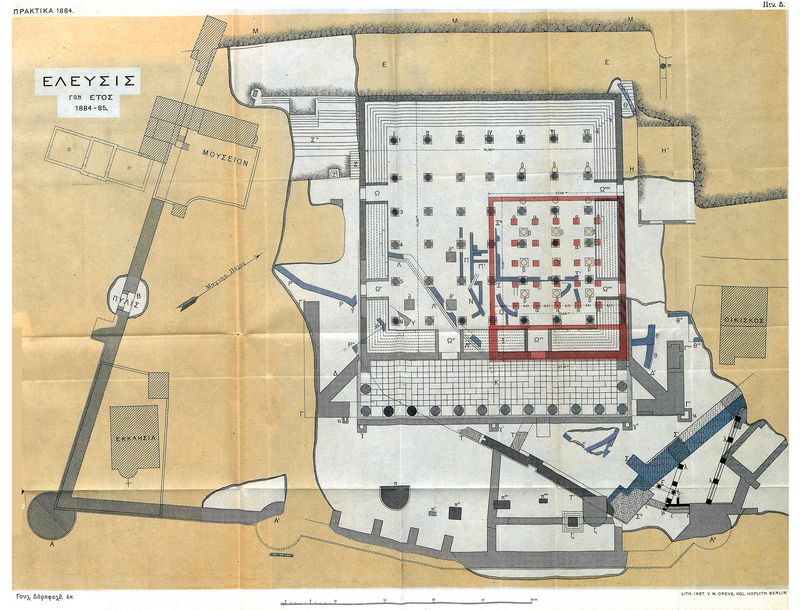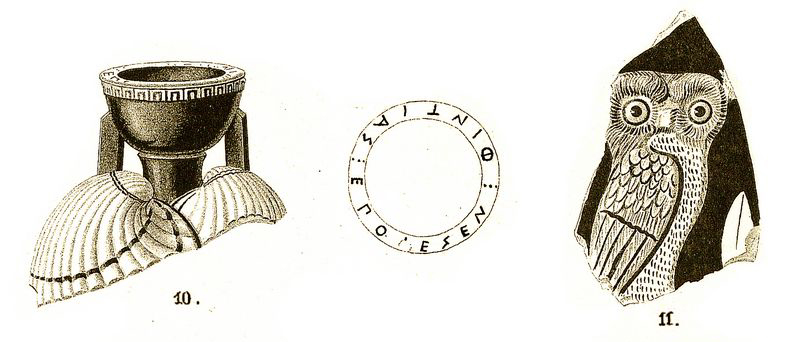|
Archaeological Findings of the Excavations at Eleusis.
[Article originally published in 1885 in Ephemeris Archaeologica (Archaeological Journal) pp.169-177]
It
has been said that the finds excavated at Eleusis were not rich
and below our expectations [1]. Of the sculptural remains of the Temple
(while, even if the zone did not have pediments, nevertheless
there were not just a few statues of divinities for worship, and many other
statues) there are almost no remains of the later years (i.e., of
the Romans), and only in the ancient part of the Temple's
courtyard are there sculptures of a of the pre-Pheidian art,
consistuting remains of the most ancient Temple during the Persian
wars, as the readers of the Archaeological Journal already know [2].
No
copper finds came to light in Eleusis during the excavations, or only a
few, and these were small or of little value; no tools were found, at
least, nor a bronze statue [3], while so many and good ones were found
in Altai, and yet the foundations of the Temple were investigated
almost everywhere, wherever possible, up to the solid, rocky ground, as
well as the floor of the Sikos to the east, where it had been leveled
for the sake of leveling [4].
For six ancient years, apparently,
in much use, Eleusinian or pelastic stone replaces with its products
those of copper technology; while on the other hand, as I have already
noted, we find clay figurines sufficient for the number and fragments
(but only fragments unfortunately and not a whole one worthy of
mention) of many vessels (including the pieces of plaques) [1].

Fig.1: Plan of Eleusis, showing areas exposed at the time of 1884-5 excavations (after Dorpfeld in Praktika Archaeologica 1884, plate 4).
But
even those that have been preserved are almost always art products of
the pre-Pheidian years; the fragments of the pottery vessels constitute
(p.171) an almost complete series from the Mycenaean to the red painted
forms of the second half of the 5th century BC.
In addition to
other and more valuable material, silver [1] and
gold artefacts came to light in these Eleusinian excavations, and
also a sufficient number of soft white material used mostly for
scarabs; about these, as well as other finds, there will be a
discussion in due course.
With the present issue of the Arch. Ephemeris,
rightly, as we hope, fulfilling the wishes of the philanthropic
readers, we are publishing the images of broken vases and plaques as
well as the well-preserved gold leaf jewelry.
In Plate 9, the
well-preserved vessels, of which there are fragments and whose shape is
truly strange and useful, are depicted at 1/3 of their actual size (2).
Plate 9 (detail): Pottery vessels 5-9 from Eleusis (Ephemeris Archaeologica 1885).
Somewhat
crude in their plan and their work, there are also those (figure
6) smeared with a fine white indelible layer, applied on them
in red or blue color, as well as indelible, flat linear (p.172) shapes, (3)
and on one (shown in figure 5) we found surviving traces of gilding in
fact on the ear-shaped (candelabra-shaped) cotylisks.
But the
most curious of them is certainly the decoration for the smaller ones
of the nipple-like, or octopus-like buttons or cotylis, the size of which
varies quite a bit in the fragments preserved [1]. The figures marked
nos. 8 and 9 are, as a simple look at the image shows, perforated caps
of similar vessels. Further, it is understood that such caps or tops also
existed for undecorated vessels, whuch as shown in fig. 6.
Other examples are depicted in no. 7, which has a tip on the lip of the mouth of the apophysis,
indicating that it is possible to assume that there
were handles up there towards the mouth, of the type now used for baskets.
Except for a few, all the rest of the vessels that
were left have, like a crown, a protrusion of them, of which there are
four, but also of six and a few, perhaps even more vertical small
holes, the reasons of which were clearly stated and in twenty of these
holes it was certainly possible to these are suspended either by a
thread or by a thin metallic wire. But the feet of most of them, being
hollow inside, bear two opposite objects (diam. 0.002-0.003), which are
clearly shown in this illustration of the vessels.
As far as I
have seen and heard it was done elsewhere; similar vessels are known.
Most of the hemeters were found at a depth of 2.00-2.50 meters under the
(p.173) floor of the Stoa of Philon, i.e. 1.00-1.50 m under the paving of
the Temple courtyard and in a layer of soil, which bore vivid traces of
burning.
These vessels were filled with coal ash, and traces
of this are still preserved in the one depicted in the drawing of no.
6. A few of these, especially of the simplest shape (6) were also
found during the excavation between the NE corner of the Temple and its
rough bricks at various depths, almost protruding into the rocky ground.
I
have no doubt about the antiquity of these, in fact the fragments that
have been preserved, from the place where they were found, I consider
to be more ancient than the Philoneios Stoa, but there is no reason to
assume that the type of these stones was in use, followed by this one
and then, and they were not similar to the layers of earth of later
generations. in later years (i.e. of the Roman era) (2).
But
what is their use? Two types of vessels are mentioned by the
ancients as especially useful in the Eleusinian Mysteries, the kernos
and the Plymochoi, but whatever their shape [3], they can have nothing
in common with the smaller Athenian vessels or in being filled with
liquid, such as the Plymochoi [4], as appropriate , (p.174) nor for the
purpose, so that the mystics seem to be handling the horn [5], adorning
most of these (not all, as I noted) cotylisks (if they are allowed to
be called so) for no practical purpose, as I think, convinced.
In
my opinion, there was nothing else about the vessels or censers, and
the perforated coverings of these were indeed most suitable for such
uses, because censers were used a lot and often, and in the Eleusinian
holy places it is understood.
In Plate 9, two fragments of vessels were depicted in their real size, marked by nos. 10 and 11.

Plate 9 (detail): Pottery vessels 10-11 from Eleusis. The rim top of vessel 10 has the inscription Phintias epoisesen ("Phintias made this") (Ephemeris Archaeologica 1885).
The
figure at left, No. 10, was considered worthy of publication with a
picture [2] not only because of the inscription on the mouth, but also
because of the strange construction of the vessel, wonderfully
imitating marine shells, the so-called kevadia.
It is a pity
that we didn't also preserve the small fragments of this vessel, the
like of which does not exist in the Society's Collection. The neck and
the mouth of it were saved, and on the outside it has a shiny black
coating, but the rim has been left red and on it is a black color and
the carefully written Phintias signature.
The craftsman Phintias is not unknown (cf. Klein, Griechische Vasen mit Meistersignaturen p. 78), but now, it seems, is becoming known as the first to make use of the verb poien "to make" or "create" [3].
p.175)
The vessel at right, no. 11 [1] was deemed worthy of publication
with an image and as a not inconsiderable example of the decoration of
vases with full-bodied animals, and at the height of the art, and
because I have not been able to find another similar one in the
Society's Collection. The vases decorated with reliefs in the
Polytechnic Collection seem to me to be products of a more recent age
and a different art method, but on these unsculptured forms the
images are at most printed and organically connected to the body of the
vessel. The colors on relief vessels, where such are present, are, as
it seems, obliterated, after
the glaze is applied, while on this fragment (fig.11) the
type is humble and seems to be an incomplete and integral part of the
entire vessel, and the colors of the owl (by which the craftsman tried
to imitate nature) are well saved and firmly on the outside
of the black coating of the vessel [2].
In Plate 8 three
fragments (1, 2 and 3) of a vessel, similar to those once found in
a tomb in Athens and published with a picture in the Archaeological Journal [3], are depicted in their actual size.
Plate 8: Pottery vessel sherds 1-4 from Eleusis with figurative designs and inscriptions (Ephemeris Archaeologica 1885).
[Return to table of contents]
|
|